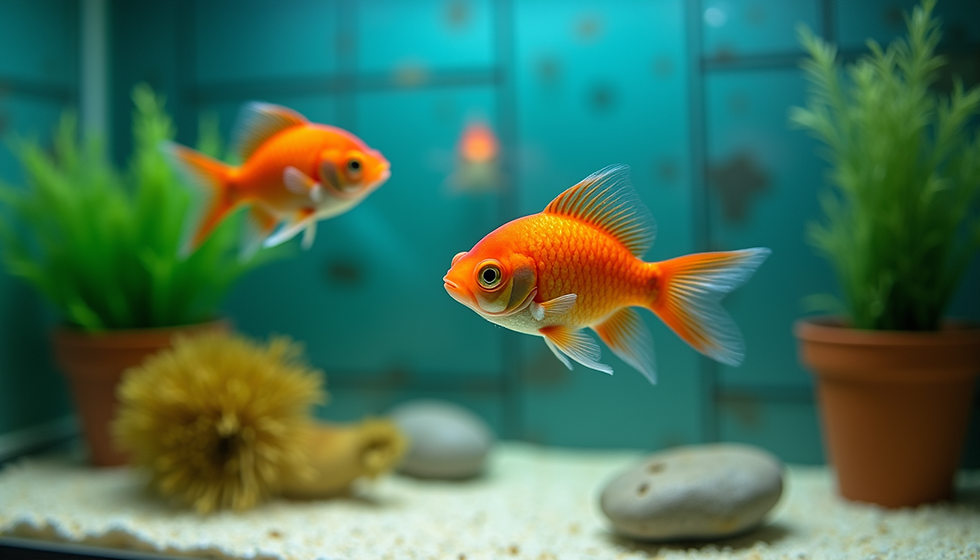Essential Care Tips for Your Home Aquarium
- John Wright-Ibarra

- May 20, 2025
- 4 min read
Keeping a home aquarium is a rewarding hobby that can bring beauty and serenity to your living space. Whether you're a novice or an experienced aquarist, proper care is essential for the health of your aquatic friends and the overall balance of your aquarium ecosystem. In this blog post, we'll explore essential care tips to ensure that your home aquarium thrives while providing you with enjoyment.
Aquarium Care Basics
Aquarium care starts with understanding the needs of the fish and plants within your tank. Each species has unique requirements regarding water temperature, pH levels, and compatibility with other fish. Researching the specific needs of your aquatic life is crucial when setting up your aquarium.
For example, tropical fish like neon tetras prefer warmer waters, while goldfish thrive in cooler temperatures. Utilizing a reliable heater and thermometer can help maintain the ideal conditions for your fish. Additionally, investing in a good water conditioner is crucial to remove harmful chemicals, such as chlorine and heavy metals, from tap water before introducing it to your aquarium.

The Importance of Regular Maintenance
Regular maintenance is vital in ensuring your aquarium remains healthy. This includes weekly water changes, routine filter cleaning, and equipment checks. Changing about 10-15% of the water weekly can help remove accumulated toxins. Make sure to use a siphon or gravel vacuum to clean the substrate and minimize waste buildup.
Filter maintenance is also crucial. Depending on the type of filtration system, you should clean or replace filter media as directed by the manufacturer. A well-functioning filter promotes good water circulation and aids in biological filtration, keeping your aquarium's environment stable.
Monitoring your water parameters is another vital aspect of aquarium care. Regularly test the water pH, ammonia, nitrite, and nitrate levels to ensure they remain within safe ranges. Many aquarium supply stores offer testing kits that can help you keep track of these key levels.
How Much Does an Aquarium Service Cost?
If you prefer to have professionals care for your aquarium, understand the costs involved. The price of aquarium services can vary widely depending on your location, the size of your tank, and the type of service required. On average, monthly maintenance fees can range from $100 to $300. Services may include routine cleaning, water testing, troubleshooting, and even emergencies, such as sick fish treatment.
For a detailed quote, you might want to search for aquarium services near me to find local professionals. Do not hesitate to ask for recommendations and customer reviews to make an informed decision.

Choosing the Right Fish and Plants
Selecting compatible fish and plants is critical to the success of your aquarium. Start by choosing species that can coexist peacefully. For instance, if you want to keep bettas, avoid housing them with other aggressive fish. Research recommended tank mates for your chosen species to create a harmonious environment.
In terms of plants, consider nutrient-absorbing species like Java Fern or Anubias, which can help maintain water quality by consuming excess nutrients. Another great option includes floating plants, which provide shade and reduce algae growth by blocking sunlight.
When designing your aquarium, think about creating layers. Include taller plants at the back and shorter ones in front. This not only looks attractive but also provides hiding spots for shy fish, making them more comfortable in their environment.
Feeding Your Fish Properly
Proper nutrition is key to maintaining healthy fish. Overfeeding is a common mistake that can lead to water quality issues and stress among fish. Feed your fish only what they can consume in 2-3 minutes, two to three times a day, depending on the species.
A balanced diet usually includes a mix of high-quality flake foods, pellets, and frozen or live foods, depending on the preferences of your fish. Consider researching the nutritional needs of your fish species and adjusting their diet accordingly.

Monitoring Fish Behavior
Regularly observe your fish for any signs of distress or illness. Changes in behavior, such as hiding, rubbing against surfaces, or unusual swimming patterns, can indicate potential health problems. Early detection is key to managing illnesses effectively.
If you notice any sick fish, it’s essential to quarantine them immediately to prevent spreading illness to the rest of your tank. Using a separate tank for sick fish can help control diseases and allow for treatments that may not be suitable for the main aquarium.
Additionally, ensure that your aquarium is not overstocked. Too many fish in one tank can lead to stress, competition for resources, and heightened susceptibility to disease. Research species' adult sizes and appropriate tank mates to maintain a healthy balance.
Final Thoughts on Aquarium Care
Maintaining a home aquarium can be a fulfilling experience that fosters a connection with nature. By following these essential care tips, you can create a thriving environment that benefits both your fish and your mental well-being. From selecting compatible species to keeping your water clean, every step is vital in achieving a balanced ecosystem.
As you embark or continue on this aquatic journey, remember that consistency and observation are key. Reach out to professionals when needed, and never hesitate to expand your knowledge about aquarium care. Happy fish-keeping!
By applying these principles and tips, you can ensure your home aquarium flourishes, providing joy and serenity for years to come.





Comments